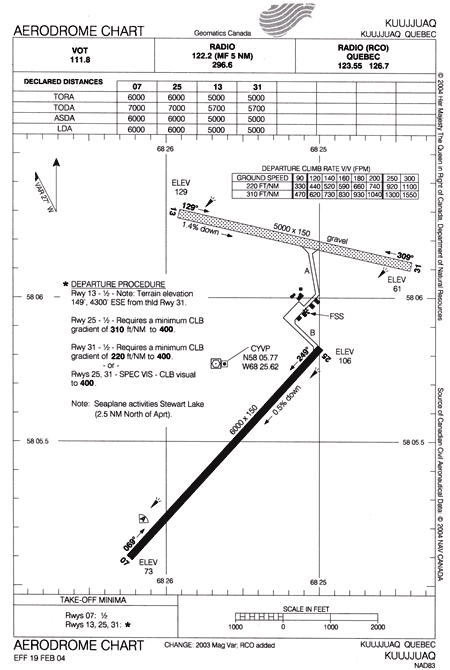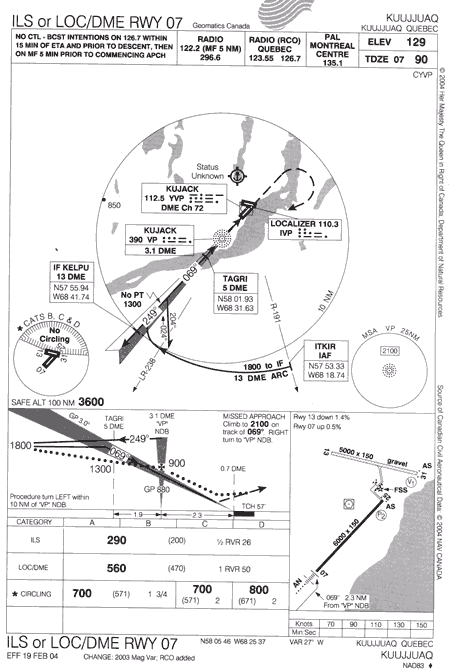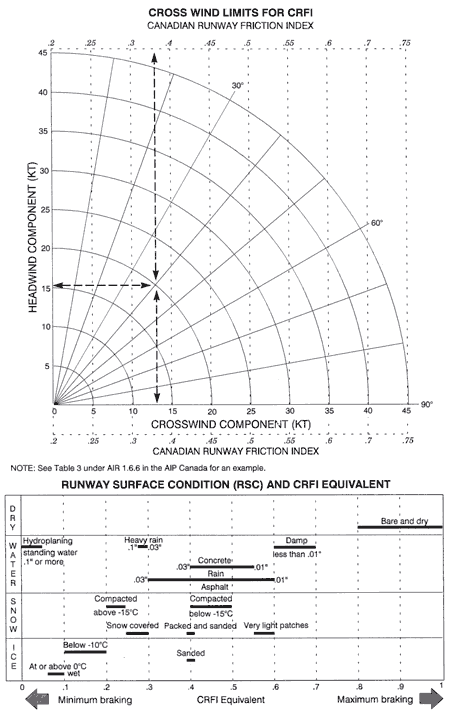Runway Excursion
Air Inuit Ltd.
BE-A100 King Air C-GAIK
Kuujjuaq, Quebec
The Transportation Safety Board of Canada (TSB) investigated this occurrence for the purpose of advancing transportation safety. It is not the function of the Board to assign fault or determine civil or criminal liability. This report is not created for use in the context of legal, disciplinary or other proceedings. See Ownership and use of content. Masculine pronouns and position titles may be used to signify all genders to comply with the Canadian Transportation Accident Investigation and Safety Board Act (S.C. 1989, c. 3).
Summary
The Beech King Air BE-A100 (registration C-GAIK, serial number B-104) departed Puvirnituq, Quebec, under instrument flight rules for a scheduled flight to Kuujjuaq. There were two crew members, four passengers, and cargo on board. Strong crosswinds and slippery runway surface conditions had been reported by the Kuujjuaq Flight Service Station personnel. The crew conducted an instrument landing system (ILS) approach to Runway 07 in instrument meteorological conditions and touched down at 1943 eastern standard time. Immediately after landing, the aircraft started skidding to the right and departed the landing surface, coming to rest 1600 feet from the threshold and 40 feet to the right of the runway. The aircraft was substantially damaged, but none of the crew or passengers was injured.
Factual information
The Kuujjuaq Airport is operated by the Kativik Regional Government. Winter snow removal and runway condition reporting are conducted as per the Kuujjuaq Airport Snow Removal Manual, which offers guidelines and procedures to the snow removal crew. Snow removal crews gave priority, as per the Snow Removal Manual, to Runway 07/25 on 24 December 2004. The James Brake Index (JBI) decelerometer equipment used to calculate the Canadian runway friction index (CRFI) was functioning correctly. The annual calibration test had been completed in September 2004.
Both pilots were licensed as required by regulations and both had completed the two-day company cockpit resource management (CRM) course. The captain had been employed with the company for 4½ years, initially flying as first officer on the Hawker Siddeley 748, then as captain on the Beech King Air. He had been captain on the King Air for 2½ years and had approximately 5500 hours of total flying time with 1500 hours on type.
The first officer had been employed with the company for 5½ years, initially flying as first officer on the Twin Otter, then as first officer on the Beech King Air. He had been first officer on the King Air for six months and had approximately 3800 hours of total flying time with 300 hours on type. At the time of the occurrence, the captain was the pilot flying and the first officer was the pilot not flying.
The aircraft initially departed Kuujjuaq at 1425 eastern standard timeFootnote 1 for Inukjuak, Quebec, and Puvirnituq. At 1812, the aircraft departed Puvirnituq for the 90-minute return flight to Kuujjuaq (CYVP). Cargo consisted mainly of company employee Christmas presents, some of which would be given out at the company Christmas gathering being held that evening in Kuujjuaq. Flight preparation, en route procedures, approach briefing, and checklist items were completed as prescribed by company guidelines.
Contrary to the forecast weather for the time of arrival, conditions in the CYVP area had deteriorated between the time of departure from CYVP at 1425 and the return at 1945. The crew was advised that winds had increased 20 knots in the last hour, with the direction unchanged. The CYVP Flight Service Station (FSS) provided the following weather to the crew when the aircraft was 97 nautical miles (nm) west of the airport:
CYVP at 1900: winds 310°T at 28 gusting to 38 knots, visibility 1/8 statute mile, RVR Runway 07, 2600 feet, moderate snow, heavy blowing snow and drifting snow, vertical visibility 200 feet, temperature −15°C, dew point −17°C, altimeter 29.09. Remarks, visibility variable from zero to ¼ mile.
After obtaining the weather for CYVP, the crew members requested the weather for the alternate airport, Wabush, Newfoundland and Labrador, and for Schefferville, Quebec, the company King Air base. They advised company dispatch that they would try one approach at CYVP and head to Schefferville if they did not see the runway environment. When the aircraft was 40 nm from the airport, the FSS specialist reported being able to see the first four or five runway lights of the threshold for Runway 25 from his vantage point in the tower (see Appendix A). This corresponded to a visibility of approximately ¼ mile.
The captain's intention was to conduct an ILS Runway 07 approach and, if conditions permitted, land on Runway 07. However, the fact that he was going to land on Runway 07 was not made clear to the first officer. The captain also indicated that, if the winds were still 40 knots, they may land on Runway 31. The first officer anticipated an approach to Runway 07 with either a circling approach to land on Runway 31 or a missed approach to Schefferville, and this information was transmitted to the FSS specialist. The decision height for the ILS Runway 07 approach is 200 feet above ground level (agl), and the circling altitude for this approach is 571 feet agl (see Appendix B). The actual wind conditions were broadcast on three occasions during the flight's approach for Runway 07, each time as being from 320° magnetic at 30 knots gusting to 45 knots.
The final approach leg was stable with light turbulence. The drift angle to maintain the localizer was not excessive; the runway environment was reported visible at the one o'clock position. The approach lights and the first six sets of runway lights were visible after passing the final approach fix (NDB VP) at an altitude of 1000 feet, and the runway environment was visible two nautical miles from the threshold, although the visibility was reported as being 1/8 mile. With the runway in sight, the captain decided to continue the approach to touchdown. A landing briefing was not conducted, nor were considerations for a crosswind landing on a slippery runway discussed. The runway environment remained visible until touchdown.
When the aircraft began its skid to the right, the captain selected the power levers to reverse, but the engines did not spool up quickly enough to aid in directional control prior to the aircraft departing the side of the runway. The captain advised the FSS of the runway excursion, and help was sent to assist the four passengers and crew. There were no reported aircraft malfunctions during the flight.
Notice to Airmen (NOTAM) on surface condition reports are issued to alert pilots to natural surface contaminants such as water, snow, ice, or slush that could affect the aircraft braking performance. Whenever possible, a CRFI reading will be issued along with the runway surface condition (RSC) report to provide an overall descriptive picture of the runway condition. On December 24, because of the changing weather conditions and precipitation, several NOTAMs in reference to RSC and CRFI were issued for CYVP. RSC and CRFI reports obtained by the flight crew before departing CYVP earlier in the day and repeated by FSS personnel during the approach were as follows:
- Runway 07/25 at 1639: RSC 90 per cent frost, 10 per cent compacted snow, temperature −12°C, CRFI 0.31; and
- Runway 13/31 at 1600: RSC 60 per cent compacted snow, 40 per cent six-inch snow drifts.
Both Aeronautical Information Publication (A.I.P. Canada), Section AIR 1.6.6, and the Canada Flight Supplement (page A64) include a reference chart that provides recommended maximum crosswind components for reported CRFI values (see Appendix C). At the maximum gust speed .reported during the flight, 45 knots, the crosswind component would be about 40 knots, with a recommended minimum runway friction coefficient of about 0.7. This approaches the coefficient of friction expected for a runway that is bare and dry.
According to recorded winds, the aircraft landed with a crosswind component of between 28 and 44 knots and a tailwind component of between 10 and 15 knots. The Beech King Air A100 aircraft flight manual states that the manufacturer's maximum demonstrated crosswind component is 25 knots. This recommended crosswind speed is not an aircraft limitation. The King Air A100 has not been tested in the conditions experienced by the flight crew.
The occurrence King Air A100 was Raisbeck-equipped (quiet turbofan propellers, dual aft body strakes, and increased gross weight). Using the Raisbeck performance chart,Footnote 2 the landing distance with a 10-knot tailwind component would be 2300 feet. With a crosswind component of 30 knots, the minimum CRFI would be 0.56. When taking into consideration the 45-knot gusts, the minimum CRFI would be 0.75.
With respect to flight restrictions related to take-off and landing, section 3, page 17, paragraph 3.21 of the company standard operating procedures (SOPs) indicates that:
At all times, it remains the Captain's responsibility to evaluate the conditions prevailing during each take off and landing (i.e.: wind, visibility, runway condition, lights, CRFI, etc.) and to determine whether or not the first officer can accomplish these manoeuvres safely.
Not withstanding this, the above manoeuvres shall be carried out by the captain whenever the 90° crosswind component exceeds 20 knots and/or the CRFI is less than 0.4.
The SOPs do not provide specific guidance with respect to maximum crosswind or minimum CRFI values for take-off or landing. It is not unusual for flight crews to operate with crosswinds beyond the manufacturer's maximum demonstrated crosswind speed for the aircraft, given that most airfields in the north are served by only one runway. The flight crew did not typically use crosswind charts while flight planning.
Analysis
The ceiling and visibility dictated a precision approach to Runway 07, but it was about 110° out of wind and very slippery. The winds favoured a landing on Runway 31, but the reported ceiling was lower than required for a circling approach. Regardless, the surface of Runway 31 was 40 per cent covered with six-inch snow drifts. The decision to fly an approach into Kuujjuaq instead of proceeding to the alternate airport indicates that the crew was not processing the significance of the information regarding wind and runway conditions. They continued an approach for which there was no viable landing option. The combination of wind speed and direction and the reduced runway friction made it unlikely that the crew would have been able to maintain control of the aircraft on landing.
Fully expecting that it was unlikely they would be able to land in Kuujjuaq, the crew indicated to the company and the FSS their intention to attempt one ILS approach to Runway 07 and then divert to Schefferville. The crew never discussed strategies for landing in the reported conditions and did not discuss which runway would be preferable for a landing. The fact that the first officer did not know that the captain was intending to land on Runway 07 did not allow the crew to properly assess the risk of landing on a slippery runway in strong, crosswind conditions.
The aircraft was established on a stable approach for Runway 07. The drift angle to maintain centreline on the approach was not unusual, and turbulence was light. Had the approach been unstable due to the strong crosswinds and/or turbulence, the crew may have perceived the risk of landing in strong crosswinds.
The maximum demonstrated crosswind speed is not an aircraft limitation. A crosswind in excess of 25 knots was acceptable to the crew. They are frequently exposed to significant crosswinds, since many of the fields they operate from are served by only one runway. Company SOPs do not provide specific guidance with respect to maximum crosswind or minimum CRFI values. Further, it was not the crew's practice to use crosswind charts in flight planning. Use of the crosswind chart in preparation for landing on Runway 07 at Kuujjuaq would have clearly shown that such a landing would have little chance of success.
Considering that it was Christmas Eve and that cargo on board the aircraft consisted mainly of company employee Christmas presents to be given at the company Christmas gathering held that evening, it is possible that there may have been some degree of self-induced pressure to complete the landing at Kuujjuaq that evening.
Findings
Findings as to causes and contributing factors
- The crew did not assimilate the information regarding wind and runway conditions, and continued an approach for which there was no viable landing option.
- The first officer did not anticipate a landing on Runway 07, which did not allow the crew to properly discuss the risk of landing on a slippery runway in strong crosswind conditions.
- The flight crew did not make use of crosswind charts during flight planning or when preparing to land at Kuujjuaq.
- Company standard operating procedures (SOPs) do not provide specific guidance with respect to maximum crosswind or minimum Canadian runway friction index (CRFI) values.
Other Finding
- It is possible that the crew may have felt some degree of self-induced pressure to land at Kuujjuaq given that it was Christmas Eve and that cargo consisted mainly of company Christmas presents.
Safety action
Air Inuit Ltd. has released a Crosswind Limits SOP Bulletin that indicates a crosswind limit for the aircraft and emphasizes the need to make reference to the prevailing runway surface conditions for both the planning and in-flight phases of the flight.
This report concludes the Transportation Safety Board's investigation into this occurrence. Consequently, the Board authorized the release of this report on .


